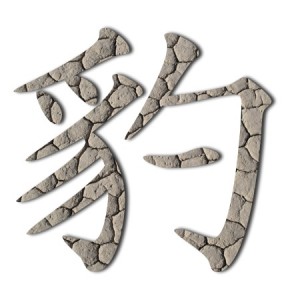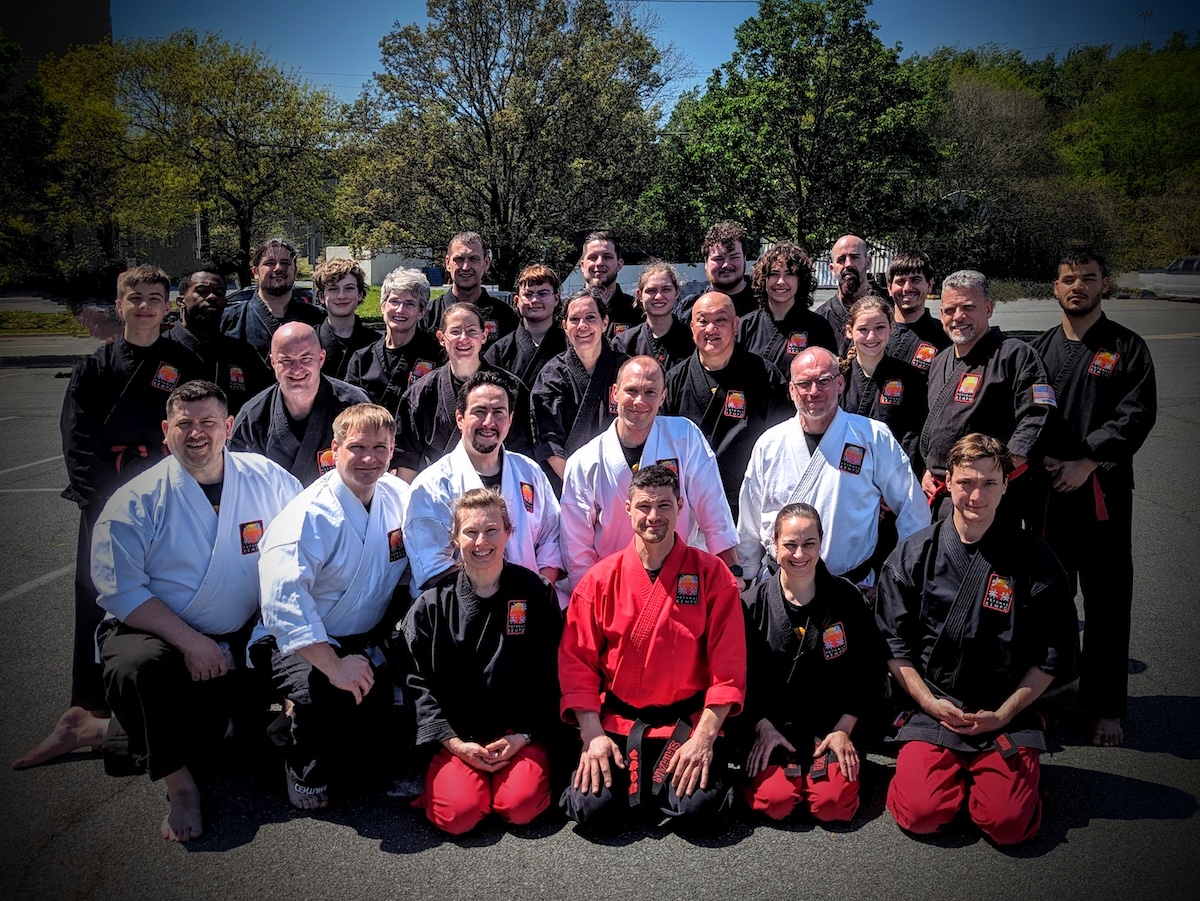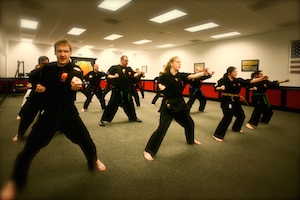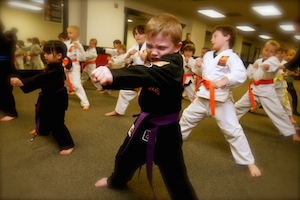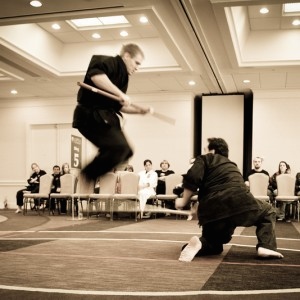Of the five Shaolin Animals, the Leopard is the only one crafted solely for martial purposes. That is to say, the other four Shaolin Animals had significant places in Chinese culture and mythology long before they were called on to be ‘martial’ animals. The Leopard, by contrast, has no cultural or mythological significance.
According to legend, during the 13th century a Shaolin Monk, Jue Yuan, with the help of masters Bai Yufeng and Li Sou developed the Five Animal System from the existing Shaolin fighting arts. The other four animals were chosen for their own reasons — many of which were cultural. The Leopard, however, was chosen because it fit a specific niche in the system. There was a gap between the fighting styles of the Tiger and the Crane. The Tiger is a hard style that attacks forward aggressively, whereas the Crane is a soft style that evades to the side and strikes to vitals. Jue Yuan and his companions rightly saw that between these two extremes there existed room for an animal that offered some of the advantages of each. To fill this gap they chose and developed the Leopard.
It is sometimes hard to visualize how Shaolin Animals would move or fight because they are such abstractions. However, in modern times there exists a nearly perfect example of the Leopard that we can observe on demand. Bruce Lee, perhaps more than anyone else in memory, was the apotheosis of the Leopard. He was small but had impeccable muscle tone, he struck quickly and powerfully, and attacked from all angles.
Fighting Style
It is sometimes said that the Leopard does not block, only attacks. This is perhaps an overstatement, but within it lies some truth. The Leopard will seldom directly block and counter as so many pugilists do, he will instead employ one of a number of advanced tactics to move past the blocking phase as quickly as possible. One method is to attack and block simultaneously, this will remove some power from the attack and remove the delay from the counter that most people expect. Another is to jab quickly — particularly in response to a larger circular attack — and then clear the attack. This allows it to deflate the attack significantly and takes good advantage of its speed. The last, of course, is to strike preemptively and repeatedly — ignoring the attack all together.
This is not to suggest that the preemptive attack will forestall all other attacks but that it will diminish their power and the Leopard will accept the strikes that land as a matter of course. Sijo Trevor Haines explained that, “Many can withstand the Leopard’s first blow, but then will be buried by the onslaught of his furious combinations.” It is in this way that the Leopard is able to limit the number of attacks that reach it.
The other components of the Leopard’s fighting style seem to blur together mostly under vague headings of ‘speed’ and ‘angles’. Though seemingly disparate, in The Art of War, Sun Tzu brings them together for us, “Rapidity is the essence of war: take advantage of the enemy’s unreadiness, make your way by unexpected routes, and attack unguarded spots.” The Leopard is one of the smaller animals and compensates in large part with speed and efficiency. It also keeps short stances to accomplish quick footwork. Quick footwork allows it to move both laterally and forward in response to attacks and as it initiates attacks. This puts the Leopard in position at angles to its opponent. From there it can shift from one stance to another, allowing both of its two hands to always be ‘rear’ hands — creating fast and powerful strikes from unexpected angles.
Striking and Blocking
The Leopard will not use fingertip strikes like a Crane but nor will it favor fists and palms like the Tiger. Its namesake, the Leopard-Paw, is formed by bending the first two knuckles of the hand, leaving the largest knuckle extended. Compared to a fist, this has slightly more range and, being smaller, more pressure to penetrate. However, compared to a finger-tip strike, it is much more stable and can apply much more power.
The Leopard will favor tender targets but is not limited to vital areas. It will seek out the throat — which the Leopard-Paw is particularly effective against — neck, solar plexus, and the groin. It can also be turned to the side as a cupped palm to pop eardrums. Next the Leopard will look to the ribs, armpits, femoral artery, and the inside of the upper arm. It will attack all of these with double, triple, and quadruple strike combinations. Calling them combinations, however, implies a degree of batching that might not be accurate. The Leopard will attack them all repeatedly until it is victorious.
The Leopard also favors quick elbows, knees, and low kicks — particularly low inward crescent kicks to the knees to the disrupt balance. By keeping kicks low the Leopard stays quick and nimble. It will endeavor more to break balance and encourage its opponent to drop his guard than to actually do damage with its feet.
In Relation to the Other Shaolin Animals
The Leopards’ advantages — his rapid attack, quick footwork, and confusing angles — depend on its mobility. Anything that prevents the Leopard from moving quickly and repositioning its feet to maximum effect is a threat to the Leopard — which is exactly how the Snake will approach a fight with a Leopard. The Snake favors two tactics — the Cobra and the Python. If the Snake were to attempt to play Cobra against the Leopard — lightning quick strikes to vitals and pressure points — the Leopard would counter with a similar response. The Leopard would employ more power than the Snake but would pinpoint its strikes less, making the outcome uncertain. However, if the Snake were to play Python the Leopard would not have a chance. The Python begins by blocking, bridging, and entwining. Initially some of the Leopards’ rapid-fire strikes will penetrate the Snakes defenses. However, individual Leopard strikes are seldom fatal — as the Leopard is relying on a barrage of strikes to overcome its opponent. As such, the Snake will withstand what strikes he receives and will ultimately entwine the Leopard. Once the Leopard is entwined its mobility is forfeit — and unfortunately — so is its advantage. From there the Snake will devour the Leopard at his leisure.
At the other end of the spectrum lies the Dragon. The Dragon relies on commitment from her opponent. She waits until her opponent launches a powerful and committed attack and then redirects his energy as she likes. The Leopard, however, never makes that powerful and committed attack. The Dragon is half defeated before she comes to realize that the barrage strikes the Leopard is launching are not ‘feelers’ or ‘setups’ but rather the attack itself. She has been hit a dozen times before she realizes her strategy will not work against the Leopard. By the time she realizes this, the fight is nearly over. There is no longer any time for her to recover. The Leopard hits her another dozen times and she falls in defeat.
When confronted with like-minded opponents, the aggressive animals — the Tiger and Snake — will destroy each other, the final result favoring the stronger and more vicious. The evasive animals — the Dragon and Crane — will never engage their counterparts, waiting indefinitely for the other to make the first move. The Leopard will end up in the middle ground. Two Leopards will, if confronted with one another, feel each other out. One will engage if it senses its own superiority and will quickly destroy its opponent. If they both lack a clear advantage they will continue to circle and attack or avoid engaging almost at random.
Physical Characteristics and Benefits
The Leopard is a very physical creature, and training as the Leopard offers tremendous physical benefits. He is known for his fast feet and his fast hands. Both of these are accomplished through a well developed musculature. People often think of speed and strength as being mutually exclusive. However, the process of moving feet or hands quickly is accomplished by using muscles in a very particular way. One can argue, therefor, that speed does not exist in lieu of strength, but rather is a category of strength.
The speed of the Leopard’s footwork is derived from a number of considerations. Some relate to how well the body is developed and some to the way it is used. The legs must be strong and lean, accomplished to a large extent with low stance training and high-repetition low-weight exercises like air squats and lunges. The legs — and all accompanying joints — are also very flexible. The hips and waist in particular must be very fluid, never interfering with a movement due to restricted mobility. When using these powerful and flexible legs, stances must be tight, with weight on the balls of the feet the majority of the time. In this way each step can be made quickly and without preamble.
Just like quick footwork, quick strikes come from a well developed body as well as attention to using it in the correct manner. The torso and arms must be well developed with lean muscle mass but they must also stay in a relaxed and ready state. With these tenets the Leopard has the ability to not only attack quickly but to choose his timing to his best advantage. Perhaps the hardest aspect of utilizing Leopard-style attacks is not striking quickly enough but maintaining control over the timing of each attack. This must be practiced and developed diligently.
Mental Characteristics
The Leopard has a youthful and enthusiastic character. It is from this character that its physical rapidity is born. This has two practical results. The first is that the Leopard is very proactive. It will be the first mover in many situations, quick to start projects and often taking the lead. The second is that it will continue to attack — either literally or figuratively — long after another would have given in. The Leopard is as close to indefatigable as an animal can be.
Leopards do not always live long but they never die of boredom.
If something critical is to be said of the Leopard’s mental character it is that its youthful countenance leads it to sometimes act impulsively. In these situations it will — sometimes quite literally — leap before looking. This will sometimes creates problems, which it must then address. This impulsive character is something that some might have expected it to have outgrown in its youth. However, it is this same impulsiveness that leads it to take three steps before many others have even begun. Whether the situation is mental or physical, life-threatening or mundane, those three steps can make an amazing difference.
Attacking From All Angles
When the world creates a challenge for the Leopard — or it creates one for itself — the Leopard will attempt to out-create the obstacle. That is to say, it will continue to confront the challenge in a variety of ways until it is overcome. In this way the Leopard is seen to “Attack From All Angles.”
From the perspective of the Leopard, the sooner a situation is addressed — or threat is obliterated — the better. It is not inclined to wait for the situation to unfold as the Crane might, rather it will react immediately, attempting to discern the best response while in the fray. If it finds that it is in a disadvantageous position, it will simply reinvent his response. There will be no pausing or regrouping to change position. The Leopard will simply change from where it is to where it wants to be without loss of momentum.
It is said that unreasonable circumstances require unreasonable responses and the Leopard lives this mantra every moment, but a little preemptively to be on the safe side. A minor situation may stay small or it could grow to be something large and overwhelming. The preference of the Leopard is to never find out which is the case. When confronted the Leopard leaps into action and Attacks From All Angles. Sometimes this will result in an amazing victory over a potentially disastrous event. Sometimes, however, it will simply result in a very large quantity of energy being expended on something that was never going to be much of a problem. The Leopard accepts this tradeoff without regret.
In Summary
It might be tempting — due to its energetic and impulsive character — to think of the Leopard as the child of the Shaolin Animals. On the contrary, it is as fully developed as its counterparts. The Leopard formulates its response to the world very deliberately. It knows its strengths and weaknesses and has developed an approach to life that suits it well.
The Leopard lacks the strength of the Tiger so it isn’t able to attack head on. It lacks the reach of the Crane so it can’t stay away. It is, however, amazingly quick and possesses tremendous stamina. As such, its best approach is to attack first, quickly, and unceasingly. We often articulate this as “Attacking From All Angles” and the variety of angles is important. However, it is its initiative that starts the attack; it is its speed that makes it possible to move between different angles without being left open; and it is its endurance that allows it to continue until it is victorious.
The Leopard is an inspiring animal. It was the last to join the other animals but it made a home for itself in Shaolin legend. It is energetic and impulsive, but not rash or foolish. It is always striving to create new positions and circumstances to best address the vagaries of life. Shifu Jason Parks captures the essence of the Leopard this way, “It is never too late to be what you might have been, and it is this unreasonable drive to express your own innate greatness that is the gift of the Leopard.”
